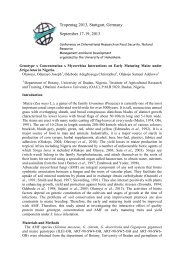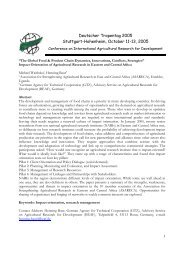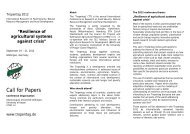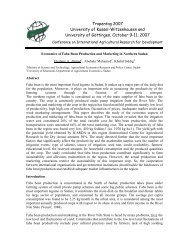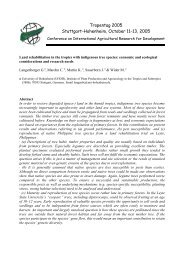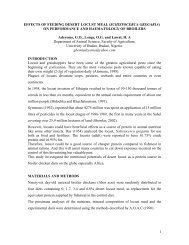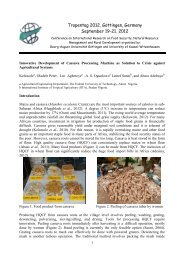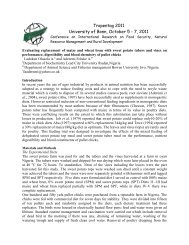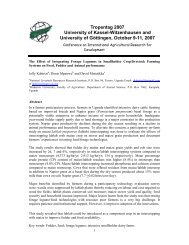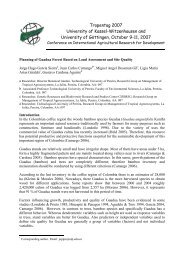factors involved in micropropagation and shoot-tip grafting - Tropentag
factors involved in micropropagation and shoot-tip grafting - Tropentag
factors involved in micropropagation and shoot-tip grafting - Tropentag
Create successful ePaper yourself
Turn your PDF publications into a flip-book with our unique Google optimized e-Paper software.
<strong>Tropentag</strong>, September 14 16, 2010 <strong>in</strong> Zurich<br />
"World Food System –<br />
A Contribution from Europe"<br />
FACTORS INVOLVED IN MICROPROPAGATION AND SHOOT-TIP GRAFTING OF<br />
APPLE (Malus domestica Borkh.) AND PEAR (Pyrus sp. L.)*<br />
Introduction<br />
Rafail S. Toma <strong>and</strong> Mosleh M. S.<br />
Department of Horticulture, College of Agriculture<br />
University of Duhok, Iraq<br />
Micrograft<strong>in</strong>g is an <strong>in</strong> vitro graft<strong>in</strong>g technique. This procedure <strong>in</strong>volves the placement of a<br />
meristem <strong>tip</strong> or <strong>shoot</strong>s <strong>tip</strong> explant onto a decapitated rootstock that has been grown aseptically<br />
from seed or micropropagated (Hartmann et al., 2002). In Iraq, the dem<strong>and</strong> of Iraqi farmers for<br />
pome fruit rootstocks is usually met by import<strong>in</strong>g them from abroad which costs the government<br />
high amounts of money. On the other h<strong>and</strong>, propagation of such rootstocks by cutt<strong>in</strong>gs is rather<br />
difficult <strong>and</strong> characterized by very low root<strong>in</strong>g success. Thus, production of good deciduous<br />
rootstocks is one of the most important objectives <strong>in</strong> horticulture <strong>in</strong>dustry. Micrograft<strong>in</strong>g has<br />
several unique uses <strong>in</strong>clud<strong>in</strong>g: production of disease-free plants by graft<strong>in</strong>g small meristem <strong>tip</strong>s<br />
(Zilka et al., 2002), virus <strong>in</strong>dex<strong>in</strong>g by micrograft<strong>in</strong>g to susceptible understocks (Zimmerman,<br />
1993), early detection of graft<strong>in</strong>g <strong>in</strong>compatibility relationships (Jonard, 1986), propagation of<br />
novel plants created <strong>in</strong> tissue cultures that are difficult-to-root (Barros et al., 2005) <strong>and</strong> small<br />
micrografted trees are a convenient way to exchange germplasm between countries (Navarro et<br />
al., 1975).<br />
The <strong>in</strong> vitro graft<strong>in</strong>g of apple <strong>shoot</strong>s has been described <strong>in</strong> a prelim<strong>in</strong>ary report<br />
(Lundergan et al., 1978) <strong>and</strong> <strong>in</strong> more detail (Sparks et al., 1977). Micrograft<strong>in</strong>g of apple was<br />
successful (Huang <strong>and</strong> Millikan, 1980). Faggioli et al. (1997) reported a successful <strong>in</strong> vitro<br />
micrograft<strong>in</strong>g of Pyrus communis <strong>shoot</strong> <strong>tip</strong>s.<br />
The major aims of the current <strong>in</strong>vestigation <strong>in</strong>cluded: develop<strong>in</strong>g a protocol for <strong>in</strong> vitro<br />
<strong>shoot</strong> <strong>tip</strong> graft<strong>in</strong>g for different cultivars to obta<strong>in</strong> a source for clean budd<strong>in</strong>g material by test<strong>in</strong>g<br />
different <strong>factors</strong> <strong>in</strong>volv<strong>in</strong>g <strong>in</strong> micrograft<strong>in</strong>g technique success. Furthermore, develop<strong>in</strong>g a skill for<br />
new <strong>in</strong> vitro graft<strong>in</strong>g techniques suitable for deciduous fruit trees production of disease-free<br />
plants.<br />
Materials <strong>and</strong> Methods<br />
The present <strong>in</strong>vestigation was conducted <strong>in</strong> Plant Tissue Culture laboratory of the<br />
Scientific Research Center at the University of Duhok, Iraq dur<strong>in</strong>g the period from January, 2008<br />
to May, 2009. Ten grafts were prepared <strong>and</strong> tested for each factor <strong><strong>in</strong>volved</strong> <strong>in</strong> graft<strong>in</strong>g procedure.<br />
Micrograft<strong>in</strong>g success was determ<strong>in</strong>ed after four weeks by the graft uptake, <strong>and</strong> the subsequent<br />
growth of the bud on the microscion. The <strong>in</strong>vestigated <strong>factors</strong> <strong>in</strong>cluded: the <strong>in</strong>teraction of<br />
rootstock <strong>and</strong> scion sources, the effect of BA on graft<strong>in</strong>g success percentage was tested by<br />
treat<strong>in</strong>g the decapitated rootstocks <strong>and</strong> the excised <strong>shoot</strong> <strong>tip</strong>s with different concentrations of BA<br />
(0.0, 0.5, 1.0 <strong>and</strong> 2.0 mgl -1 ) for 10 m<strong>in</strong>. prior to micrograft<strong>in</strong>g. In a separate experiment, BA was<br />
added to the nutrient medium used for culture of grafted plants at 0.0, 0.5, 1.0 <strong>and</strong> 2.0 mgl -1 ,<br />
different sucrose concentrations were <strong>in</strong>vestigated as well by add<strong>in</strong>g 15, 30, <strong>and</strong> 45 g/l to the<br />
nutrient media, To determ<strong>in</strong>e the need for aeration <strong>in</strong> the grafted plants <strong>and</strong> to compare between<br />
the graft<strong>in</strong>g success percentages <strong>in</strong> both agar solidified medium <strong>and</strong> liquid medium, the effect of<br />
1
the physical status of the medium was also tested. Agar (7 g/ l) was used <strong>in</strong> the case of solid<br />
medium <strong>and</strong> agar was omitted <strong>in</strong> the case of liquid medium, an agar drop from the solidified<br />
culture medium was placed on the cut area of the rootstock to help <strong>in</strong> avoid<strong>in</strong>g desiccation, which<br />
may enhance the union between scion <strong>and</strong> stock, two k<strong>in</strong>ds of support<strong>in</strong>g agents (filter papers <strong>and</strong><br />
cotton) tested <strong>in</strong> the case of us<strong>in</strong>g liquid medium <strong>in</strong> order to clarify their effects on micrograft<strong>in</strong>g<br />
success, <strong>and</strong> two different methods of micrograft<strong>in</strong>g were tested, <strong>in</strong>verted T-budd<strong>in</strong>g <strong>and</strong> Cleft<br />
(Split) graft<strong>in</strong>g to exam<strong>in</strong>e their effects on micrograft<strong>in</strong>g success percentage.<br />
All experiments were designed as r<strong>and</strong>omized complete block design (RCBD). The<br />
comparison between means was carried out accord<strong>in</strong>g to Duncan's mul<strong>tip</strong>le range test (P < 0.05)<br />
us<strong>in</strong>g a computerized program of SAS (SAS, 2001).<br />
Results <strong>and</strong> Discussion<br />
Figure (1, A) demonstrates that different graft<strong>in</strong>g success percentages were achieved<br />
between different apple <strong>and</strong> pear rootstocks <strong>and</strong> scions comb<strong>in</strong>ations. The highest micrograft<strong>in</strong>g<br />
success (90%) was obta<strong>in</strong>ed while graft<strong>in</strong>g P. calleryana pear on P. calleryana stocks followed<br />
by 80% micrograft<strong>in</strong>g success percent <strong>in</strong> case of the graft<strong>in</strong>g of MM106 apple scions on MM106<br />
apple stocks which were significantly higher than the graft<strong>in</strong>g of heterograft<strong>in</strong>g between different<br />
cultivars. High significant percentage of successful grafts (80%) was obta<strong>in</strong>ed when <strong>shoot</strong> <strong>tip</strong>s of<br />
Anna apple <strong>and</strong> Aly-Sur pear were obta<strong>in</strong>ed from tissue culture grown plantlets, as compared to<br />
the lowest percentages of successful grafts (30 <strong>and</strong> 40%) which were obta<strong>in</strong>ed when <strong>shoot</strong> <strong>tip</strong>s<br />
were obta<strong>in</strong>ed from flushes <strong>in</strong> trees grown under field conditions (Figure 1, B).<br />
A significant difference was noticed <strong>in</strong> apple micrograft<strong>in</strong>g success while us<strong>in</strong>g <strong>in</strong> vitro<br />
micropropagated <strong>shoot</strong>s as rootstocks (60%) when compared with the use of <strong>in</strong> vitro germ<strong>in</strong>ated<br />
seedl<strong>in</strong>gs (48%). The same micrograft<strong>in</strong>g success (60%) was achieved for pear micrograft<strong>in</strong>g<br />
with both k<strong>in</strong>ds of rootstocks (Figure 1, C).<br />
The effect of BA on the ability of graft union to form successfully varied from 30 to 90%<br />
between the four treatments. The success rate of the untreated (control) microscions was<br />
significantly lower than the other treatments with 40 <strong>and</strong> 30% for both apple <strong>and</strong> pear,<br />
respectively. Medium supplemented with 2 mgl -1 BA produced the highest graft<strong>in</strong>g success<br />
percent (90%) for apple, whereas medium supplemented with 1 <strong>and</strong> 2 mgl -1 BA gave the highest<br />
graft<strong>in</strong>g success percent (90%) for pear (Figure 1, D). This confirmed the value of us<strong>in</strong>g<br />
cytok<strong>in</strong><strong>in</strong>s to improve graft<strong>in</strong>g success by promot<strong>in</strong>g <strong>and</strong> <strong>in</strong>duc<strong>in</strong>g callus growth <strong>and</strong> the<br />
formation of graft union between rootstocks <strong>and</strong> scions. Figure (1, E) shows that dipp<strong>in</strong>g<br />
rootstocks <strong>and</strong> scions <strong>in</strong> different BA concentration solutions before micrograft<strong>in</strong>g had no<br />
significant <strong>in</strong>fluence on micrograft<strong>in</strong>g success <strong>in</strong> both apple <strong>and</strong> pear. In the four treatments,<br />
wetness of microscions <strong>and</strong> the graft area caused the failure of the graft union to form. Only 10 to<br />
40% graft unions formed successfully.<br />
Micrograft<strong>in</strong>g success improved with the <strong>in</strong>crease <strong>in</strong> sugar levels till 30 g/l <strong>in</strong> both apple<br />
<strong>and</strong> pear micrografts. The mean values were 50% <strong>and</strong> 40% at 15 g/l sucrose level which rose up<br />
to 60% <strong>and</strong> 70% at 30 g/l level but graft<strong>in</strong>g success percentage lowered down to 30 <strong>and</strong> 40% on<br />
the media supplemented with 45 g/l sucrose for both apple <strong>and</strong> pear micrografts, respectively.<br />
The mean values <strong>in</strong>dicated that sugar levels <strong>in</strong>fluenced the graft success whereas both apple <strong>and</strong><br />
pear responded almost similarly (Figure 1, F). Figure (1, G) shows that us<strong>in</strong>g liquid medium<br />
raised successful grafts percentage to 60 <strong>and</strong> 70% from only 10% <strong>in</strong> case of solidified media with<br />
agar for both apple <strong>and</strong> pear micrografts, respectively. These results confirmed that us<strong>in</strong>g liquid<br />
medium was more effective than solid media.<br />
Figure (1, H) declares that micrografts <strong>in</strong> which an agar drop was added to their grafted<br />
area were highly succeeded (70 <strong>and</strong> 60%) as compared with those grafted without an agar drop<br />
(10%) for both apple <strong>and</strong> pear micrografts respectively. The major cause of micrograft<strong>in</strong>g union<br />
failure without an agar drop might be due to desiccation (George et al., 2008). Add<strong>in</strong>g an agar<br />
2
drop usually prevents scion dry<strong>in</strong>g <strong>and</strong> makes the transport of different materials possible <strong>and</strong><br />
holds the graft units together until the fusion took place. Micrograft<strong>in</strong>g successes of 50 <strong>and</strong> 60%<br />
<strong>and</strong> 60 <strong>and</strong> 70% were obta<strong>in</strong>ed while us<strong>in</strong>g filter paper <strong>and</strong> cotton for both apple <strong>and</strong> pear<br />
micrografts, respectively (Figure 1, I).<br />
The comparison between T-budd<strong>in</strong>g <strong>and</strong> cleft graft<strong>in</strong>g (apex <strong>shoot</strong>-<strong>tip</strong>) methods on<br />
successful grafts of apple <strong>and</strong> pear is shown <strong>in</strong> figure (1, J). By <strong>in</strong>verted-T <strong>in</strong>cision there were 80<br />
<strong>and</strong> 90% successful micrografts <strong>in</strong> Anna on MM106 apples <strong>and</strong> Aly-Sur on P. calleryana pears,<br />
respectively. Lower success of 70% <strong>in</strong> both apple <strong>and</strong> pear was observed when scion was grafted<br />
by surface placement us<strong>in</strong>g cleft graft<strong>in</strong>g.<br />
The <strong>in</strong> vitro micrograft<strong>in</strong>g of apple <strong>and</strong> pear was successfully achieved. The establishment<br />
of a micrograft<strong>in</strong>g protocol for clonally propagat<strong>in</strong>g true-to-type mature apple <strong>and</strong> pear genotypes<br />
might be an efficient technique overcom<strong>in</strong>g conventional apple <strong>and</strong> pear propagation problems.<br />
In vitro graft<strong>in</strong>g of 0.1-0.2 mm-long <strong>shoot</strong> <strong>tip</strong>s on two weeks old rootstock seedl<strong>in</strong>gs or <strong>in</strong> vitro<br />
rooted <strong>shoot</strong>s enabled gett<strong>in</strong>g successful grafts that could be transplanted to soil with high<br />
survival rates. Shoot <strong>tip</strong> graft<strong>in</strong>g might also have important application of basic research <strong>in</strong> the<br />
field of graft compatibility, physiology of graft union <strong>and</strong> plant ag<strong>in</strong>g. A high mortality rate was<br />
found with grafted plants transferred to soil. Successful gradually acclimatized micrografts of<br />
both apple <strong>and</strong> pear reached to 85 <strong>and</strong> 90%, respectively. Figure (2) shows successful apple<br />
micrograft<strong>in</strong>g on liquid medium <strong>and</strong> us<strong>in</strong>g different support<strong>in</strong>g agents.<br />
3
References<br />
Barros, M. T. F., C. I. Hipolito <strong>and</strong> C. G. M. Baptista. (2005). In vitro root<strong>in</strong>g of Portuguese pear<br />
cultivars (Pyrus communis) <strong>in</strong> response to changes <strong>in</strong> aux<strong>in</strong> <strong>in</strong>duction <strong>and</strong> dark period<br />
treatments. Acta Hort., (671) 631-636.<br />
Faggioli, F., L. Mart<strong>in</strong>o <strong>and</strong> M. Barba. (1997). In vitro micrograft<strong>in</strong>g of Pyrus communis <strong>shoot</strong><br />
<strong>tip</strong>s. Advances <strong>in</strong> Hort.<br />
Scienc., 11 (1): 25-29.<br />
George, E. F., A. H. Michael <strong>and</strong> D. K. Greek-Jan. (2008). Plant Propagation by Tissue Culture<br />
(3 rd Edition). Vol. 1. The Background. Spr<strong>in</strong>ger.<br />
Hartmann, H. T., D. E. Kester, F. T. Davies <strong>and</strong> R. L. Geneve. (2002). Plant Propagation,<br />
Priciples <strong>and</strong> Practices. 7 th Edition. New Jersey: Prentice Hall.<br />
Huang, S. <strong>and</strong> D.F. Millikan. (1980). In vitro micrograft<strong>in</strong>g of apple <strong>shoot</strong> <strong>tip</strong>s. Hort. Scienc., 15:<br />
741-743.<br />
Jonard, R. (1986). Micropropagation <strong>and</strong> its applications to tree improvement, p.31-48. In: Y.P.S.<br />
Bajaj (eds). Biotechnology <strong>in</strong> Agriculture <strong>and</strong> Forestry. Vol. 1. Trees I. Spr<strong>in</strong>ger-Verlag,<br />
Berl<strong>in</strong>.<br />
Lundergan, C., V. C. Pence <strong>and</strong> J. Janick. (1978). In vitro graft<strong>in</strong>g of apple. P. 260. Technical<br />
Information Center, U.S. Department of Energy. (Abstr.).<br />
Navarro, L., C. N. Roistacher <strong>and</strong> T. Murashige. (1975). Improvement of <strong>shoot</strong> <strong>tip</strong> graft<strong>in</strong>g <strong>in</strong><br />
vitro for virus-free Citrus. J. Am. Soc.Hort. Sci. 100: 471-479.<br />
SAS. (2001). SAS/ STAT User’s Guide for Personal Computers. Release 6.12. SAS Institute Inc.<br />
Cary, NC, USA.<br />
Sparks, T. R.; A. J. Campbell <strong>and</strong> J. B. Sweet. (1977). Elim<strong>in</strong>ation of viruses us<strong>in</strong>g meristem<br />
culture technique. Rpt. Long Ashton Res. Sta. for 1976. p. 34.<br />
Zilka, S., E. Fa<strong>in</strong>gersh, A. Rotbaum, Y. Tam, S. Spiegel <strong>and</strong> N. Malca. (2002). In vitro<br />
production of virus-free pear plants. Acta Hort., 596: 477-479.<br />
Zimmerman, J. L. (1993). Somatic embryogenesis: A model for early development <strong>in</strong> higher<br />
plants. Plant Cell, 5, 1411-1423.<br />
4



